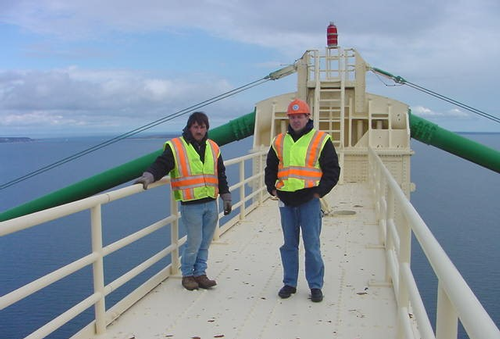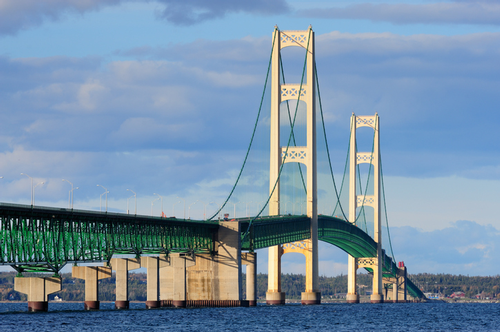THURSDAY, JUNE 15, 2017
Bryon Beck, coatings specialist with the Michigan Department of Transportation, has been with MDOT for more than 40 years, working with coatings for the past 36. During that time, he’s seen plenty of changes in the world of abrasive blasting and surface preparation in general, working primarily with the state’s many bridges, including famous international crossings and the Mackinac Bridge, the fifth-longest suspension bridge in the world.

 |
| Courtesy of Bryon Beck |
|
Bryon Beck (seen here at right, at the top of one of the towers of the Mackinac Bridge), has 36 years' experience in coatings work with the Michigan Department of Transportation. |
Beck spoke with PaintSquare News about his observations regarding abrasive blasting and abrasive choice, and the changes that have come about in the past four decades.
How did you get involved in coatings-related work with MDOT?
I guess I sort of fell into it. I was in construction for about seven years, and I came over here for an interview for a concrete person, or that’s what I thought I came in for. The people who were supposed to interview me weren’t around—so they sent me down and said to interview with [another official]. He was a paint person, not a concrete person. He needed an assistant, so that got me started.
What structures are you generally working with?
Predominantly structural steel bridges; [in the] last four to five years, coating concrete structures.
If you were speaking with a contractor who's new to the industry, what would be the first thing you'd tell them to take into consideration when choosing an abrasive media for a given job?
Use the appropriate abrasive type and gradation to meet specifications—larger isn’t necessarily better. Using an abrasive gradation that produces a surface profile in excess of specifications, [requires] the usage of more coating.
For the most part, our contractors want the most aggressive one they can get. They forget that we have criteria for minimum and maximum profile. A lot of times, that is exceeded, at least on the jobs that I know of. That does worry me: that on a certain percentage of the jobs that I go out to, there’s high profile.
 |
| © iStock.com / gnagel |
|
Michigan's many bridges include the Mackinac, the world's fifth-largest suspension bridge. |
Some of that could be because it’s already existing. For instance, back when we used red lead, I think the profile was as high as 3.9 (mils), and we now max out at 2.8. So it could be an existing condition, or maybe when we painted with a different system in recent years, the previous contractor [prepared it to] an excessive profile.
I was on a job this spring where [the contractor was] using steel grit, and it was a size that was for a 3 to 5 mil profile. You’d have to pressure down a lot to get the profile we’re looking for [with that abrasive size]. But they’re looking for more aggressive abrasives. And sometimes you need that when you have mill scale, but on a bridge that was painted previously, you don’t need that—the mill scale’s not there. Or hopefully it’s not there.
You mentioned using too large an abrasive will require the use of more coating—it seems like such a small thing, but does that really add up?
Well, yeah: If you increase the size of—if you want to call the peaks and valleys “mountains”—you’re creating more surface area. And quite honestly, paint is probably one of the cheaper things that’s out on the job, so to [a contractor], it probably doesn’t seem like much of an issue. But the problem is, some of the paint manufacturers have maximums that they want, that you should not exceed.
What’s changed the most in the world of abrasives and surface preparation since you’ve been in the industry?
Containment and its evolution. The first containments we ever put up were basically to stop paint from going onto traffic; we’d put it on the downwind side in front of traffic, then we’d put it on the other side, and that was about all the intent was.
 |
| Chris Light, CC BY-SA 3.0, via Wikimedia Commons |
|
The Blue Water Bridge, built in 1938, stretches from Port Huron, Michigan, to Sarnia, Ontario. |
Then, of course, we realized there was a lead issue. We started working on our Blue Water Bridge, which is an international bridge from Port Huron, Michigan, to Sarnia, Canada. Our crews had always done the maintenance on our side of the bridge, and they’d just go in with a single pot and do spot repairs. That didn’t generate much noise.
Then the first contract goes out, a contractor comes in with full guns, and of course they have a much larger compressor and generator. People complained about the noise, and that was the big issue—when in reality they should have been concerned about the bridge coating being red lead, and the materials being dropped right down onto the ground near the structure.
So then somebody said, “Well, what about the lead?” And we started investigating—this was the mid-‘80s, maybe—then we started developing containment, negative pressure, that type of thing.
At one point, we had different specifications, if it was urban, rural—now it’s all the same. Nothing is supposed to be escaping the containment.
What do you think the next trend is with regard to abrasives and blasting?
I have no idea. There are different innovations out there: We’ve looked at robotics, but that’s not practical because of the different designs we have of bridges—for the regular, smaller spans, you probably could come up with a robotic system that could work for a lot of those, but all of our bridges are different to some degree. We’re also looking into lasers, but I don’t like that so much, because it doesn’t leave enough of a profile. There are a number of things we’ve experimented with in the past, but it just never materializes because of difficulty, or expense, or whatever.
Tagged categories: Abrasive blasting; Abrasive size; Abrasives; Bridges; Containment; Structural steel; Surface preparation; Surface Preparation